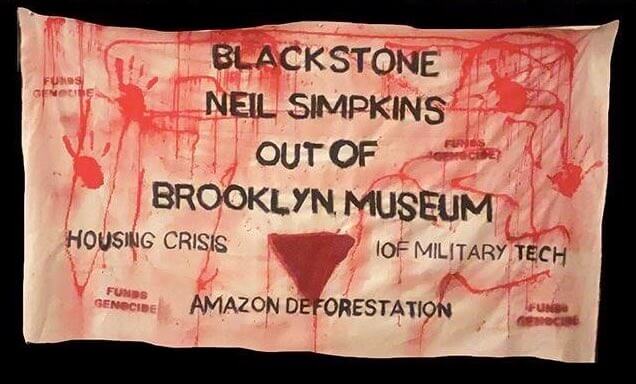How everyone got the Brooklyn Museum story wrong
“Antisemitism Notebook” is a weekly email newsletter from the Forward, sign-up here to receive the full newsletter in your inbox each Tuesday
Many progressives are reluctant to accept allegations of antisemitism because they feel like these claims are often made in bad faith to damage their political movement. It was striking, then, to see so many prominent left-wing leaders — along with the rest of the political spectrum — unequivocally condemn the activists who spray-painted the homes of four Brooklyn Museum leaders last week:
- Brad Lander, New York City’s comptroller and an outspoken progressive, was the first to weigh in early Wednesday morning on X: “Vandals defaced the homes of the Jewish director and several Jewish board members,” he wrote. “The cowards who did this are way over the line into antisemitism.”
- Jumaane Williams, the city’s public advocate, agreed: “Targeting and attempting to intimidate Jewish New Yorkers is unacceptable.”
- And Maya Wiley, the progressive standard-bearer in the last mayoral race, similarly condemned “singling out Jewish leaders of the Brooklyn Museum.”
And Rafael Shimunov, who hosts a radio show for the Jewish left on WBAI, recognized that the vandalism made his allies look bad. “Right-wing Zionists do dress up as Palestine protesters to smear the movement with antisemitism,” he cautioned shortly after the news broke.
The story went viral, with the New York Post and The New York Times reporting that all of the targets were Jewish and Politico stating it had caused “a reckoning for the left.” President Joe Biden provided a capstone Friday when he condemned “vandalism targeting Jewish homes.”
The widespread disapproval stemmed from the understanding that protesters had specifically targeted Jews.
“There are many people on that board,” Jonathan Greenblatt, the Anti-Defamation League director, said on MSNBC. “They didn’t go after anyone else besides the Jews.”
There was just one problem: Only one of the four museum leaders, director Anne Pasternak, was Jewish.
Anatomy of an error
Lander was the first to share that Jewish board members had been targeted alongside Pasternak but his office would not tell me what he based that on.
Amy Spitalnick, chief of the Jewish Council for Public Affairs, said she heard from a board member who “understandably assumed those targeted were all Jewish” and shared that on X one minute after Lander in a post that has received 2.4 million views.
Last night vandals defaced the homes of the Jewish director & several Jewish board members of the @brooklynmuseum.
The cowards who did this are way over the line into antisemitism, harming the cause they claim to care about, and making everyone less safe. pic.twitter.com/MzEVgJYCwQ
— Brad Lander (@bradlander) June 12, 2024
The Post — a right-wing tabloid that has latched onto the antisemitism beat in recent years — never attributed where it heard that the board members were Jewish, and still hasn’t corrected its original article. The Times, which assigned three reporters to the story, issued a correction blaming the museum for telling them that all the victims were Jewish before softening that language. The Forward also issued a correction.
Many people affiliated with the museum initially believed that all of the leaders hit — in addition to Pasternak, they included the museum’s president, board chair and treasurer — were Jewish. Two of them, Barbara Vogelstein and KP Trueblood, are married to Jews, although the museum told me: “no one confirmed the faith identities of our board members with the Times. There was a lot of wide misreporting.”
Andrew Bates, a White House spokesperson, said in an email that Biden’s statement about “targeting Jewish homes” referred to more than the Brooklyn Museum incidents but only pointed me toward vandalism at a Los Angeles Chabad House that took place nearly a week before the time period Biden referenced.
Confirmation bias
Lander and Spitalnick — who seem to have inadvertently kicked off the false reporting — said the revelation that only one of the victims was Jewish did not change their assessments. “This should not take away from the very real antisemitism at the core of these actions,” Spitalnick told me.
The vandalism at Pasternak’s home alone was likely enough to merit that sentiment. Protesters accused her of being a “white supremacist Zionist,” although she has never publicly supported Israel, and marked her windows with the red triangle that has become a pro-Hamas symbol.

Vogelstein was also accused of being “Zionist scum.” In contrast, the banner outside the home of Neil Simpkins, a third board member without a particularly Jewish name, focused on substantive criticism of the investment bank where he works. (I could not find images of what happened outside Trueblood’s home.)
In other words, there’s plenty to critique about the action, which is part of a confusing feud between protesters and the museum. But the claim that activists only targeted Jews turned the incident into a black-and-white case of antisemitism — a dangerous tactic given that the claim turned out to be false.
“The boy-who-cried-wolf approach actually hurts the fight against antisemitism,” wrote Yonah Liberman, a founder of IfNotNow.
READ MORE:
- ‘Abhorrent’: NY officials deplore attacks on homes of Brooklyn Museum director, board members (Forward)
- Vandals painted a red triangle on the home of a Jewish museum director. What does it mean? (Forward)
The post How everyone got the Brooklyn Museum story wrong appeared first on The Forward.
from The Forward https://ift.tt/OC3UirW
Comments
Post a Comment